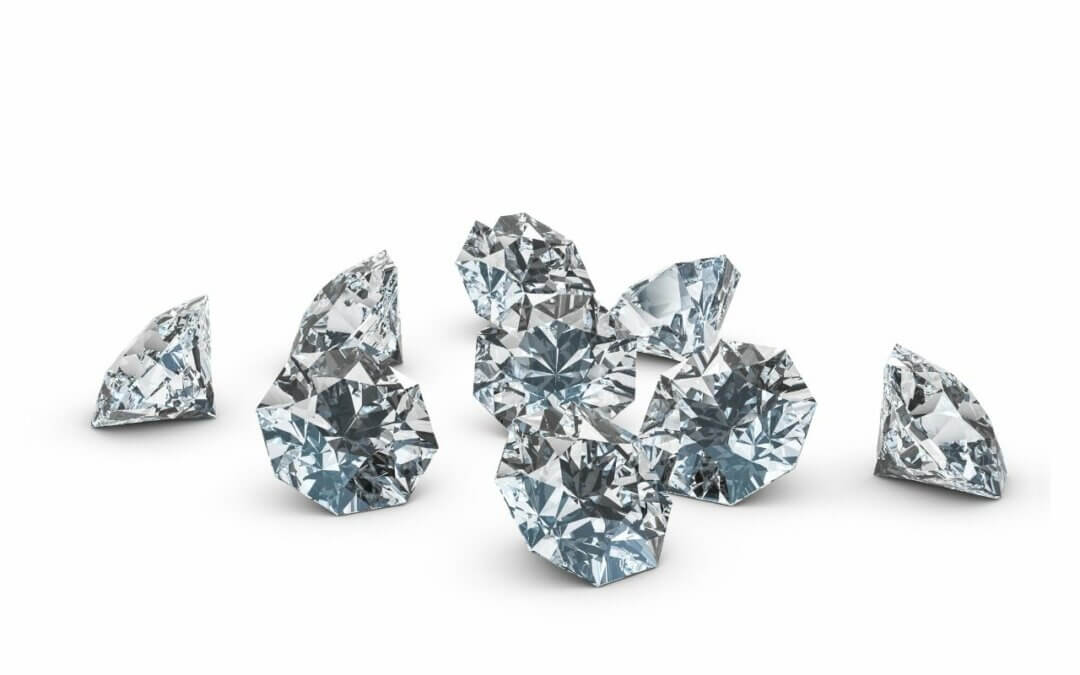Although diamonds are often thought of as being rare and valuable, that is not always the case. In fact, there are a number of simulant diamonds on the market that look very similar to the real thing.
A simulated diamond is not a real diamond, but it looks and behaves like one. They are made of high-quality materials that allow them to replicate the look and feel of a natural diamond. Simulated diamonds are perfect for people who want all the benefits of owning a diamond without having to worry about the cost or maintenance that comes with owning a natural stone.
With simulated diamonds, you can have all the sparkle and brilliance of a real diamond at a fraction of the price, making them a popular alternative to natural diamonds. They are also durable and long-lasting, so you can enjoy your ring for years to come without any worry.
So what exactly is a simulated diamond? And what makes it different from a real diamond?
What Is A Simulated Diamond And How Is It Different From A Real Diamond?
Simulated diamonds are also referred to as diamond simulants or artificial diamonds. These gems are created in laboratories using advanced technologies that mimic the natural processes that form real diamonds. Among the most popular diamond simulants is cubic zirconia (CZ), which is designed to resemble a diamond.
While diamond simulants share some characteristics with diamonds, there are key differences. For instance, cubic zirconia has similar physical and chemical properties to diamonds, including hardness (8-9 on the Mohs scale). However, it lacks the brilliance and fire of real diamonds because of its lower refractive index. This makes it less desirable compared to diamonds or lab-created diamonds. Despite these differences, many simulants, like moissanite, are crafted to be almost indistinguishable from natural diamonds.
The primary difference between a simulated diamond and a real diamond lies in their origin and composition. Real diamonds are natural minerals formed deep within the earth through immense heat and pressure, and they are mined as rough stones before being cut and polished. These stones are the hardest substance on Earth, with a perfect score of 10 on the Mohs scale, and boast a high refractive index that gives them exceptional brilliance.
In contrast, simulated diamonds are man-made and do not possess the same chemical structure or hardness. While they may resemble a diamond, their optical properties differ significantly. Simulated diamonds are crafted to mimic the look of real diamonds, but they lack the unique qualities of natural diamonds. This distinction is critical when comparing diamonds vs simulants.
Why Choose Simulated Diamonds?
Although simulated diamonds differ from natural diamonds, they have many advantages. For one, they are far more affordable, making them a practical choice for engagement rings, wedding bands, and other jewelry pieces. These stones often look like a diamond and can offer a similar aesthetic at a fraction of the cost. Additionally, modern simulants, like moissanite or cubic zirconia, are durable and visually appealing, making them a preferred choice for budget-conscious buyers.
While natural diamonds are still considered more valuable due to their rarity and unmatched brilliance, the difference between diamond simulants and real diamonds is becoming harder to distinguish thanks to advancements in manufacturing. For those seeking the elegance of diamonds without the expense, popular diamond simulants offer a compelling alternative.
How Are Simulated Diamonds Made?
Simulated diamonds are created using various advanced techniques, depending on the type of diamond simulant being produced. For example, cubic zirconia (CZ), one of the most popular diamond simulants, is made by melting zirconium oxide and cooling it rapidly. This process results in a stone that is hard and durable, much like a real diamond, offering a practical diamond alternative.
Another example is moissanite, which is crafted using a method known as chemical vapor deposition (CVD). In this process, gases are broken down into their component parts and deposited onto a substrate to form a crystal. This technique is similar to how a lab diamond or lab-created diamond is made and can produce simulant diamonds that closely mimic the appearance of natural diamonds. These simulants are nearly diamond-like, with physical properties that are comparable to those of mined diamonds.
What Are The Benefits of Simulated Diamonds?
When shopping for jewelry, don’t hesitate to explore the options available with simulated diamonds. With advancements in technology, it’s becoming increasingly difficult to distinguish simulated diamonds from lab-grown diamonds or even natural diamonds. Many diamond simulants, such as CZ or moissanite, are now nearly indistinguishable from natural diamonds, offering brilliant alternatives that are both affordable and durable.
Moreover, simulant diamonds provide the same elegance and beauty as real diamonds, often at a fraction of the cost. As prices for synthetic diamonds and other alternatives to diamonds continue to become more competitive, these gems offer an excellent way to achieve a diamond-like look without breaking the bank. Whether you’re looking for a timeless piece or something to match your budget, created diamonds and other simulants are an appealing choice.
What Are The Most Popular Types Of Simulated Diamonds On The Market Today?
Simulated diamonds have been around for centuries, with early examples appearing as far back as the 1700s. In recent years, however, there has been a significant rise in the popularity of synthetic diamonds due to technological advancements. Today, these diamonds are crafted from a variety of materials and are available in a range of colors to suit diverse preferences.
One of the most common types of simulated diamonds is cubic zirconia. Cubic zirconia is one of the most widely used diamond simulants, prized for its ability to closely mimic the appearance and hardness of natural diamonds. Jewelry pieces made from cubic zirconia often resemble diamonds in brilliance and can be cut and polished to achieve an elegant finish. While cubic zirconia may not possess the same chemical or physical properties as a naturally occurring mineral like a diamond, it remains a popular and affordable alternative. However, unlike natural diamonds, cubic zirconia lacks the exceptional optical qualities that make diamonds so unique, making it a more budget-friendly option for jewelry lovers.
Another compelling alternative is the lab-created diamond. Unlike cubic zirconia, which mimics diamonds in appearance, lab-created diamonds are identical in structure to naturally occurring diamonds. These stones are grown in a controlled environment and share the same chemical composition and hardness as natural diamonds. They can be cut and polished to perfection and are designed to last a lifetime. Additionally, lab-created diamonds are produced more quickly and at a fraction of the cost of naturally occurring minerals, making them an increasingly popular choice for engagement rings and fine jewelry.
Natural Diamonds vs. Synthetic Diamonds
While natural diamonds remain the most sought-after gems on the market, synthetic diamonds are gaining popularity due to their affordability and accessibility. Lab-created diamonds offer a sustainable alternative to naturally occurring diamonds, combining luxury and environmental consciousness. Similarly, cubic zirconia is one of the most accessible and versatile options, appealing to those seeking beautiful jewelry at a lower price point.
Whether you’re considering a lab-created diamond or jewelry made from cubic zirconia, both alternatives provide excellent options for those looking for pieces that are stylish, durable, and timeless. As more consumers become familiar with these choices, synthetic options continue to close the gap with natural diamonds in appeal and demand.
Are There Any Risks Associated With Buying And Wearing Simulated Diamonds?
The main risk with simulated diamonds is that some people may mistake them for mined diamonds, especially if they are not clearly labeled. This can lead to confusion about whether diamonds are created in a lab or sourced naturally. However, most reputable jewelers ensure transparency by clearly labeling diamonds and lab-grown options, allowing buyers to make informed decisions.
Many consumers prefer diamonds created using laboratory methods because they are not extracted from the earth, eliminating concerns about environmental degradation. These diamonds offer an eco-friendly alternative to traditional options and are often priced significantly less than mined diamonds. Furthermore, moissanite is a popular choice among lab-created gems due to its brilliance and affordability, offering the allure of a dream diamond without the hefty price tag.
Ethical concerns also play a role in the growing popularity of diamonds made in labs. Some believe that mined diamonds may be associated with human rights abuses, especially in conflict zones. In contrast, lab-created diamonds are produced under controlled conditions, ensuring they are ethically sourced. While diamond prices for mined stones often reflect their rarity and value over time, lab-grown diamonds provide an accessible alternative for those seeking high-quality gems at a higher price-to-value ratio.
Despite the risks of mislabeling, diamonds and lab-grown options are widely recognized as a responsible choice for modern consumers. Their environmental and ethical advantages make them a popular diamond option, providing beauty and value while maintaining transparency and sustainability.
Are Simulated Diamonds As Good As Real Diamonds In Terms Of Quality And Durability?
Real diamonds are natural gemstones that are mined from the earth. Simulated diamonds, on the other hand, are created in a lab by humans. So, which one is better?
When it comes to quality, simulated diamonds and real diamonds are usually equal. In most cases, it is impossible to tell the difference between a natural diamond and a simulated one with the naked eye.
However, natural diamonds may have small imperfections called inclusions, which can give them character and make them more valuable.
In terms of durability, real diamonds are usually harder than simulated diamonds. This means that they are less likely to scratch or chip over time. However, both types of diamonds are quite strong and immune to damage from everyday wear and tear.
How Much Do Simulated Diamonds Cost, And Where Can They Be Bought?
The answer depends on a number of factors, including size, quality, and cut, which are also crucial when comparing simulated diamonds to natural diamonds. For example, a one-carat round brilliant cut lab-grown diamond could cost anywhere from $2,000 to $8,000.
That being said, it is possible to find simulated diamonds for as little as $100. Where can they be bought? Simulated diamonds are sold by a number of online retailers, as well as some brick-and-mortar jewelers.
However, it is important to note that not all jewelers carry lab-grown diamonds. If you’re interested in buying a simulated diamond engagement ring, it’s best to do your research beforehand to make sure you’re working with a reputable seller.
What Are Some Tips For Taking Care Of A Simulated Diamond Ring Or Necklace?
Tips for taking care of simulated diamond jewelry. When it comes to diamond mining and simulated diamond jewelry, there are a few things you need to keep in mind in order to keep it looking its best.
First, simulated diamonds are not as hard as real diamonds, so they can be scratched more easily. To avoid this, store your simulated diamond jewelry in a soft pouch or box away from other harder pieces.
Second, simulated diamonds can also lose their luster over time if they are not cleaned properly. To clean your simulated diamond jewelry, simply use a mild soap and water solution and avoid using harsh chemicals or detergents.
Finally, keep in mind that simulated diamonds are not as resistant to heat as real diamonds, so avoid exposure to extreme temperatures.
Conclusion
Simulated diamonds are an excellent choice if you’re looking for a beautiful piece of jewelry that won’t break the bank. If you’re willing to spend a little more money, a natural diamond might be a better option for you.
Ultimately, the best choice is the one that fits your budget and your personal preferences.



Recent Comments